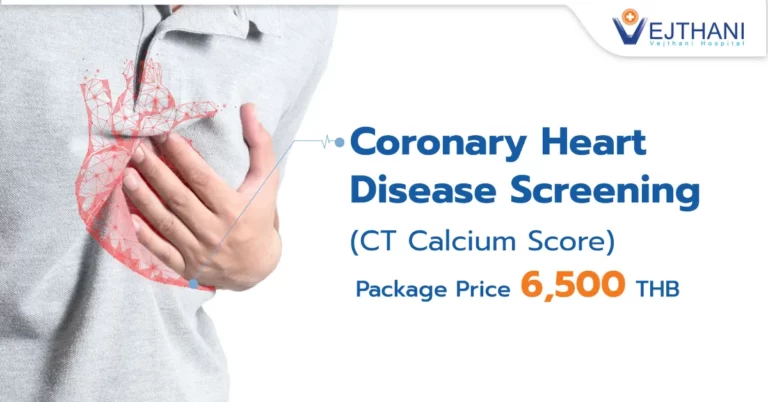Specialist Treatments for Diabetes Types 1 and 2
Established in 2006 and headed by prominent endocrinologist Dr Thawatchai Pasurakul, the Diabetes Center at Vejthani Hospital provides a full range of diagnostic, therapeutic and educational services for patients with type one and two diabetes.
The Diabetes Center is located in the Endocrine Center on the 1st floor of Vejthani Hospital and opens daily from 7:00 am – 4:00 pm. The centre offers private consultation and physical exams, imaging and laboratory testing, thyroidectomy (the surgical removal of the entire thyroid gland), dietary consults, prevention and treatment services, and group education/therapy classes.
According to the World Health Organization, the world is home to over 422 million children and adults with diabetes. They estimate that about a third of them are unaware that they even have the disease. Annually, approximately 1.6 million deaths are directly attributed to the condition, and if left untreated may cause blindness, kidney failure, heart disease, stroke, nerve damage and lower limb amputation.
The difficulty in diagnosing diabetes is that the symptoms often occur over an extended timeframe; on average people with type 2 diabetes go undiagnosed for 4-7 years. More often than not, the physician will make a diagnosis based on complications – heart problems, vision impairment, slow-healing sores, tingling feet – from diabetes, rather than directly from the disease itself.
Personalized diabetes treatment makes all the difference to long-term health, and achieving balanced treatment can be the key to living with both type 1 and type 2 diabetes. A variety of different factors have a role to play in treating diabetes, but the importance of balanced, co-ordinated diabetes treatment for all diabetics cannot be underestimated.
Type 1 Diabetes
Type 1 diabetes occurs when the pancreas cannot produce an adequate supply of insulin. The hormone insulin helps cells use glucose (derived from food intake and the liver) for energy. Glucose that can’t be adequately absorbed builds up in the bloodstream resulting in high blood sugar.
Excessive blood glucose levels can severely harm every system in the body. Because type 1 diabetes occurs typically in children and young adults, it is sometimes called ‘juvenile’ diabetes. However, type 1 diabetes can strike at any time in life. The disease is evenly distributed among the sexes and is more common among Caucasians than other racial groups. Typically, type 1 diabetes accounts for 5-10% of all diabetic cases diagnosed.
Type 1 diabetes is believed to be caused by a genetic predisposition to the disease. This genetic predisposition lies dormant until triggered by a virus, toxin, or drug which attacks the immune system and beta cells of the pancreas.
Who’s at risk?
Risk factors for type 1 diabetes include:
- A parent or sibling with the disease
- Auto-immune disorder such as thyroid disease
- History of childhood viruses such as rubella, adenovirus, Epstein-Barr
What are the signs?
Type 1 diabetes develops rapidly, and its symptoms (see list below) can be quite dramatic.
- Excessive hunger or thirst
- Frequent urination
- Slow-healing wounds
- Dry skin
- Rapid breathing
- Blurred vision
- Mood swings
- Unexplained weight loss
- Headaches
- Tingling in extremities
- High blood pressure
Diagnosis
These symptoms, however, could also be indications of other illnesses. To confirm a type 1 diabetes diagnosis, the doctor will perform a blood test. Usually, a plasma glucose test is administered. The patient must fast for 8 hours after which blood is drawn for the test. Other tests for type 1 diabetes include the random plasma glucose test in which blood can be taken any time of the day, and, the oral glucose tolerance test at which blood is drawn at three-hour intervals after the patient drinks 75 grams of glucose.
Health risks
Over time, type 1 diabetes complications can affect major organs in your body, including heart, blood vessels, nerves, eyes, and kidneys. Eventually, diabetes complications may be disabling or even life-threatening, in particular with regards to the following:
- Heart and blood vessel disease
- Nerve damage (neuropathy)
- Kidney damage (nephropathy)
- Eye damage.
- Foot damage
- Skin and mouth conditions
- Pregnancy complications
Treatment
The goal of type 1 diabetes treatment is to maintain blood glucose levels as close to normal as possible. To do this, patients replace the insulin their pancreas cannot produce by injecting themselves with insulin via an insulin injection or an insulin pump. Self-monitoring blood glucose kits allow patients to see how diet, exercise, and other factors affect their glucose levels.
In addition to insulin replacement, type 1 diabetics must make lifestyle changes that will keep their diabetes under control. A healthy diet, regular exercise, and regular blood glucose monitoring are crucial to managing type 1 diabetes and reducing the risk of severe complications from the disease.
Type 2 Diabetes
Type 2 diabetes is the most common form of diabetes, with nearly 95% of diabetic cases being diagnosed as such. Also known as adult-onset diabetes, type 2 diabetes can occur in children and teens. In recent years, type 2 diabetes has been on the rise among the young as children have succumbed to obesity and sedentary lifestyle problems of adults.
The muscle, liver, and fat cells in a type 2 diabetic’s body are unable to use the insulin produced by the pancreas properly; this is called insulin resistance. The hormone insulin helps cells use glucose, derived from food intake and the liver, for energy.
As the pancreas becomes unable to supply an adequate amount of insulin, glucose builds up in the bloodstream, while cells are simultaneously starved for energy. High glucose levels damage nerves and blood vessels, which in turn lead to serious diabetes complications throughout the body.
Who’s at risk?
Researchers believe heredity plays a strong part in type 2 diabetes. People having a parent or sibling with the disease are 10-15% more susceptible to developing type 2 diabetes. Other factors include:
- Ethnicity (persons of South Asian, African and Caribbean descent)
- Bodyweight (body mass index of 25 or more)
- History of gestational diabetes or having given birth to a baby over 9 lbs
- High blood pressure or cholesterol
- Sedentary lifestyle
- Overage 65
- Diagnosed as pre-diabetic (blood glucose level higher than normal)
What are the signs?
Type 2 diabetes progresses gradually; many people are diagnosed once they experience complications from the disease such as blurred vision or foot pain. There are several symptoms of type 2 diabetes. While these signs could also indicate other illnesses, it is advisable first to get tested for diabetes if you have one or more of the following:
- Excessive hunger or thirst
- Frequent urination
- Slow-healing wounds
- Dry skin
- Rapid breathing
- Blurred vision
- Mood swings or depression
- Unexplained weight loss
- Headaches
- Tingling in extremities
- Frequent infections (urinary, yeast, skin)
- High blood pressure
Diagnosis
Three plasma blood glucose tests are available for diagnosing type 2 diabetes. The most commonly used test – fasting plasma glucose (FPG) – requires the patient to fast for 8 hours after which a blood sample is taken.
In another test, blood is drawn at any time during the day (random plasma glucose). The oral glucose tolerance test requires a patient to drink 75 grams of glucose; blood is then drawn in intervals up to 3 hours afterwards.
Health risks
Type 2 diabetes can cause serious harm to all parts of the body, including the cardiovascular system. Heart disease is one of the leading complications of type 2 diabetes. Other diabetes-related health problems include:
- Nerve damage
- Vision problems (glaucoma, cataracts, blindness)
- Kidney disease
- Sexual dysfunction
- Dry, cracked skin (susceptible to infection)
- Gum disease
Treatment
Once a person is diagnosed with type 2 diabetes, they may need medication to help control the condition. Oral medications are often prescribed when diet and exercise alone can’t keep blood sugars in check. Likewise, a type 2 diabetic will usually need insulin injections to control glucose levels. Insulin is injected using a syringe or infused with an insulin pump. Patients must regularly check their glucose levels by using a self-monitoring blood glucose device.
A healthy diet and regular exercise will help prevent or delay the onset of type 2 diabetes. It is also essential to maintain healthy blood pressure and cholesterol levels, and, to avoid excessive weight gain.
Diabetes Center Bangkok Thailand
- Readers Rating
- Rated 4.9 stars
4.9 / 5 ( Reviewers) - Spectacular
- Your Rating



























